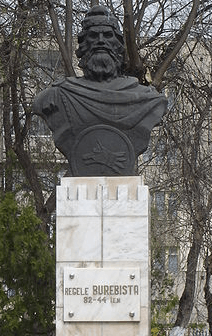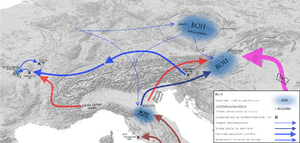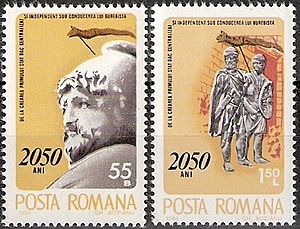Burebista facts for kids
Quick facts for kids Burebista |
|
|---|---|
| King of Dacia | |

Statue of Burebista located in Călărași
|
|
| Reign | 82/61–44 BC |
| Died | 45/44 BC |
Burebista (Ancient Greek: Βυρεβίστας, Βοιρεβίστας) was a powerful Thracian king who lived a long time ago, from about 82 BC to 44 BC. He was the first king to bring together many different Getae and Dacian tribes. These tribes lived in a large area called the Dacian Kingdom. This kingdom was located where modern-day Romania and Moldova are today, between the Danube, Tisza, and Dniester rivers.
The Getae and Dacians were related groups of people who lived in this region. For a while, their culture was influenced by the Celts, who brought new tools and ways of doing things. But around 150 BC, the Dacians became stronger and eventually pushed the Celts out of their lands. The Dacians often fought with their neighbors, but living in the Carpathian Mountains helped them stay safe and grow. By the 1st century BC, the Dacians were the strongest tribe in the area.
Starting around 61 BC, Burebista began to expand his kingdom. He conquered several tribes, including the Boii and Taurisci, and probably the Scordisci. He also led raids into other lands like Thrace, Macedonia, and Illyria. From 55 BC, he took over the Greek cities along the Black Sea coast. These victories made him a very powerful ruler.
Burebista's growing power led to conflict with the mighty Romans. In 48 BC, he supported Pompey during a Roman civil war. This made him an enemy of Caesar, who planned to attack Dacia. However, Caesar was assassinated in 44 BC. Around the same time, Burebista himself was killed by some Dacian nobles who didn't like his strong rule. After his death, the large kingdom he had built broke apart into smaller parts.
Contents
The Dacian Kingdom
The land that is now Romania was home to different Thracian peoples, including the Getae and Dacians. This was around the 7th to 6th centuries BC. The Getae and Dacians were similar in culture and language. The Getae lived near the lower Danube River and traded with Greek cities. The Dacians lived closer to the Carpathian Mountains. This location helped them survive conflicts and become the leading tribe by the 1st century BC.
Before Burebista, the Dacians had other kings like Dromichaetes and Rubobostes. From the 4th to 2nd centuries BC, the Celts influenced Dacian culture. They brought new things like the potter's wheel and better metalworking. There's evidence that Celts and Dacians lived together and shared ideas. But after 150 BC, the Dacian culture grew stronger, and the Celts either left or blended in. Burebista's rule brought a stable kingdom and a stricter way of life.
Burebista's Rule
When Burebista Became King
Historians don't all agree on the exact year Burebista became king. Some say it was around 82 BC, while others suggest it was closer to 61 or 60 BC. What is clear is that he built a powerful empire in the 1st century BC. Around 61 BC, he pushed the Celts out of the middle Danube region. He also had the support of religious leaders, which helped him set up a strong moral code in his kingdom.
Conquests and Foreign Policy
Conquering Neighboring Tribes
Around 61 BC, Burebista started a series of military campaigns. He defeated the Boii and Taurisci tribes in what is now modern Bohemia and Slovakia. These tribes had moved into areas like eastern Austria and Hungary. Burebista's forces heavily defeated them around 50-40 BC. He also conquered the Bastarnae and likely the Scordisci peoples. His armies raided through Thrace, Roman Macedonia, and Illyria.
Taking Greek Cities
Around 55 BC, Burebista began to take over the Greek cities along the Black Sea coast. He captured fortresses from Olbia to Apollonia. These cities included Olbia, Tyras, Histria, Tomis, Callatis, Odessos, Messembria, and Apollonia. One city, Dionysopolis, had a good relationship with Burebista. An important person from Dionysopolis, Akornion of Dionysopolis, was described as Burebista's "first and greatest friend." Akornion was sent to Pompey to ask for Burebista to be called "king of kings."
Conflict with Rome
Burebista's power eventually led to clashes with Rome. During the Roman civil war of 49–44 BC, Burebista supported Pompey. However, Caesar defeated Pompey. Caesar knew that the Dacians were becoming very strong and saw them as a threat. He planned to attack Burebista. Some sources say Burebista had a huge force of up to 200,000 men, though this might have been the total number of able-bodied men in his kingdom. Either way, Dacia was a powerful force. But Caesar was assassinated in 44 BC, so his plan never happened. Burebista also died around the same time, killed in an uprising.
Burebista's Death
Burebista died shortly after Caesar, either in 45 or 44 BC. He was killed by Dacian nobles who felt that his strong, centralized rule was taking away their power and special rights. After his death, the large Dacian kingdom broke apart into several smaller kingdoms. Only a small area around the Orăştie Mountains remained united. By the time of the Roman emperor Augustus, Dacia was divided into five different parts.
Dacia After Burebista
After Burebista's death, the Dacians were mostly focused on defending their lands from the Romans. The smaller Dacian kingdoms were not a big threat to Rome, and the Romans stopped planning invasions for a while. Dacian power grew strong again under kings like Duras (68–87 AD) and especially under Decebalus (85/87-106 AD). Decebalus managed to unite the Dacian tribes once more, and they again became a threat to Rome.
Decebalus's reign was marked by almost constant fighting with the Romans. Around 85 AD, Dacian raids started again in Roman territories. The Roman emperor Domitian launched an attack, but it ended in a big defeat for the Romans. A second Roman attack in 88 AD was more successful, but both sides suffered heavy losses. Domitian then made a quick peace treaty with Decebalus in 89 AD. Rome had to pay money and provide technical help to Dacia. In return, Dacia became a kind of "client kingdom" to Rome, acting as a buffer against other tribes.
This peace lasted for about ten years. Then, Trajan became emperor in 98 AD. Trajan immediately strengthened the Roman borders. In 101–102 AD, Trajan gathered a huge army of up to 150,000 men to fight Decebalus, who had about 50,000. The Roman army entered Dacia and defeated the Dacian forces at Tapae. This forced Decebalus to ask for peace. Trajan agreed but set very strict terms. Decebalus did not follow these terms, so Trajan launched a second campaign in 105 AD. By 106 AD, Trajan had fully conquered Dacia, ending its independence as a kingdom.
Burebista's Legacy
In modern Romania, Burebista and the Dacians are seen as important ancestors. In the 1920s and 1930s, nationalist movements used the image of brave Dacians to suggest a pure origin for the Romanian people. At the same time, the Romans were sometimes preferred to show Romania as a civilized nation.
In the 1960s, statues of Burebista and Decebalus were put up in Socialist Romania. This was part of a move to become more independent from the Soviet Union. The kings were shown as freedom fighters, and big celebrations were held for ancient battles. Two government-funded films, Dacii and The Column, focused on Dacian history and Decebalus, but Burebista was mostly ignored.
In the 1970s, the government under Nicolae Ceaușescu used history to support its rule. In 1980, Romania celebrated the 2,050th anniversary of Burebista's "unified and centralized" Dacian state. They tried to compare Ceaușescu's Romania to Burebista's kingdom, suggesting a continuous history. A movie called Burebista (1980) was released, showing him as a national hero. The press even found "similarities" between Burebista and Ceaușescu.
Today, some Romanian nationalists see Burebista and his descendants as the true ancestors of their nation. Historians note that this view of history was used for political reasons during Ceaușescu's time. For example, Ceaușescu's brother wrote that archaeological evidence showed "uninterrupted ethnic, political, and military continuity of the Romanians." Similar historical arguments are sometimes used by Hungarians regarding the Transylvanian region.
|
See also
 In Spanish: Burebista para niños
In Spanish: Burebista para niños





